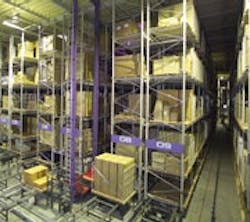Relays might seem to be in retreat for all but the most basic control applications in the face of seemingly relentless PLC advances. Instead, relays actually are adding capabilities and encroaching into control territory formerly occupied by PLCs.
Figure 1: This automated storage & retrieval system from Daifuku America handles materials and is controlled by a combination of relays and programmable controllers.
Today’s relays and programmable relays are better than PLCs in two main categories. Traditional relay functions such as voltage conversion, current amplification and electrical isolation fall into the first category.
“We generally use power relays for high power or large inductive loads,” says Carl Van Tilburg, PE, electrical engineer in the controls department of Daifuku America (www.daifukuamerica.com). “The nature of these loads demands a hardened component with load-breaking capabilities.” Daifuku is located in Reynoldsburg, Ohio, and makes a variety of material handling and assembly line equipment (Figure 1).
The second category includes control functions for which relays are a better alternative in terms of cost, performance and ease of use. “For our retrofit control application, we needed a simple-to-install, low-cost, add-on solution, and programmable relays filled the bill,” explains Jeffrey Smith, product support manager at MEC Aerial Work Platforms (www.mecawp.com) in Selma, Calif. MEC manufactures a variety of electric and internal-combustion-powered self-propelled aerial-work platforms for the construction industry (Figure 2). For MEC’s application, a PLC was too complex and expensive, so it instead used a type of pre-programmed relay.
Let’s look in more detail at instances and applications where relays and programmable relays are a better solution than low-end PLCs.
PLCs Can’t Do This
Figure 2: This scissor lift has a working height of 43 ft and platform capacity of 1,000 lb. It is available in diesel, dual fuel (gas/propane) or all-electric power configurations. MEC Aerial Work Platforms uses a programmable relay as the primary control device for its scissor lifts.
PLCs continually add capabilities, but these additional functions usually improve control, connectivity and performance. This leaves the field wide open for relays in traditional application areas. Some of these tasks can be performed by PLCs, but not practically from a cost/performance perspective.
“Solid-state and electromechanical relays excel at conversion, amplification and isolation,” observes Mike Garrick, product marketing lead specialist for Phoenix Contact (www.phoenixcon.com). “Relays often are used to convert 24 Vdc to 120 Vac so machines can use safe, low-voltage control, with relays switching to higher voltages as required. For example, a 24 Vdc PLC output might control a 24 Vdc relay coil that would toggle a 120 V solenoid on and off.”
Relays commonly are used to amplify current so low-cost, high-density and low-current PLC outputs can drive high-current loads. For example, a 24 Vdc/500 mA output point from a PLC could connect directly to the coil of a relay, and the relay contacts could drive a high current load.
[pullquote]As isolators, relays protect critical control components from dangerous loads and electrical noise. “When power is removed, inductive dc load devices collapse the magnetic field in an attempt to sustain current flow,” explains Garrick. “As a result, a voltage spike is generated and sent to whatever source is turning the device off and on. A relay contact can absorb the kickback voltage spike.”
Jim McConahay is a senior field applications engineer with Moore Industries (www.miinet.com), and he details some other electrical advantages of relays and programmable relays over PLCs. “Programmable relays have much higher inherent RFI/EMI protection than PLCs, often as high as 50 V/m,” notes McConahay. “Robots and machinery often are positioned by or controlled by VFDs, which produce a tremendous amount of electrical interference, so noise immunity is important.”
Replacing a damaged programmable relay requires a fraction of the time and cost of replacing a PLC; it takes up much-less cabinet space than a PLC does and generates much less heat than a PLC does, adds McConahay.
Safe by Design
MEC Aerial Work Platforms (www.mecawp.com) in Selma, Calif., manufactures a variety of electric and internal-combustion-powered, self-propelled aerial work platforms for the construction industry. “We faced an issue where the machine operators, after running the diesel engine out of fuel, would over-crank and damage the starter in attempt to re-prime the fuel system,” relates Jeffrey Smith, product support manager at MEC. “We needed a single-unit controller to monitor and temporarily interrupt the start system in order to allow some cool-down time.
ABB’s ProgramaCube fit well with our current electrical system without having to make any significant changes. Basically it was a plug-and-play arrangement that we could offer to our clients at minimal cost to us.”
This unit was required to monitor the duration of the start command, including cumulative time in case the operator tried to outsmart the protective device, and then interrupt the start command for a period of time to match the duty cycle of the starter. The solution had to serve as a retrofit as well as a production change so the requirement was for a simple-to-install and low-cost add-on.
“We contacted five different suppliers,” says Smith. “The other companies provided us with a variety of timed relays with limited programmability, but it was the cumulative timer requirement that only ABB could provide.”
ABB programmed the device based on conversations with MEC and then provided MEC with pre-production samples for testing. “We installed each sample on a production machine and attempted to override, trick, bypass and basically destroy the unit,” continues Smith. “We also tested the unit in a variety of ambient conditions and with varying voltages. After testing, the ProgramaCube was released as a standard ABB part in early 2008. We have not had one failure of the unit.”
The ProgramaCube cost is as little as a third of a user-programmable logic device, says Eric Biss, product manager of electronic products at ABB (www.abb.com). “While a micro PLC allows programming, it also demands a knowledgeable user,” he explains. “We sell both programmable relays and micro PLCs, and one of the most common customer requests is to have us develop the program. So, our ProgramaCube leaves the factory pre-programmed and 100% tested for the customer's application. It has only the required connections and has a 10-year warranty. All units are fully encapsulated and the solid-state models have no moving parts. We can include features like a 30 A/1 hp-rated output, hard to find on a programmable relay or a PLC.”
Relays fail to a predictable state on power loss, making them ideal for many safety-system applications. “Some machine-control applications must adhere to industry safety standards such as IEC 61508 or 61511,” notes McConahay. “Programmable relays come with these approvals at a fraction of the cost of a safety PLC. Safety integrity level (SIL) 2/3 programmable relays cost as little as a few hundred dollars, where many SIL 2/3 safety PLCs cost thousands of dollars. These PLCs also require special documentation and personnel when programmed and commissioned. Programmable relays use push buttons, potentiometers or free PC programming software that any technician can use.”
GE Energy’s Steve Sabin is the task secretary for API 670, an American Petroleum Institute mechanical equipment standard dealing with machinery protection instrumentation. “To my knowledge,” he states, “relays are the only viable option for applications above SIL 1. I don't think there is any digital communications protocol yet considered appropriate for SIL 2 or SIL 3 applications.”
GE builds electronic machinery protection systems that meet API 670 and other industry standards. “Although there is some discussion currently in the task force about revising the standard to allow the use of digital protocols, it does not appear that this will be allowed when the installation has to meet a designated SIL,” explains Sabin.
Relays in Control
Relays and programmable relays have a host of electrical and safety advantages over PLCs, but programmable relays also can outshine PLCs in real-time control and monitoring.
“We’ve used programmable relays to control several small accumulation sections on conveyors,” explains Daifuku’s Van Tilburg. “The advantage over a standard PLC was solely price. The programmable relay is better-suited for small, stand-alone, low-complexity applications. Once integration into a system or high control complexity is required, the programmable relay loses it applicability.”
As Van Tilburg notes, higher control complexity favors PLCs, but the very simplicity and limited capability of programmable relays confers ease-of-use. “Programmable relays can be programmed by technicians via push buttons or free PC programming software,” reminds Moore’s McConahay. “Most PLCs still require licensed software and always need a person skilled in PLC programming.”
In addition to ease-of-use, control advantages of programmable relays over PLCs often are price-related. “Many programmable relays have local displays and LEDs that display input faults, relay status and the process variable,” notes McConahay. “PLCs need an additional-cost HMI along with software to accomplish the same tasks.”
Using relays for signal conversion lets a low-cost PLC be employed as the main controller, while the relays perform specialized duties.
Relays mounted on printed circuit board often can replace PLCs in machine control applications—saving space and money.
“We engineered a custom electromechanical relay PCB for a material-handling machine that integrated nearly 85% of the machine’s discrete panel components,” says Carey Perschke, electronics and manufacturing engineering supervisor at Wago (www.wago.us). “The machine builder was looking for a way to trim costs by eliminating a separate power supply while minimizing the overall footprint for the controls. The PCB integrated two electromechanical relays with photosensor relay control. The board is just 3.1x4.9 in. and includes a universal-voltage 24 Vdc regulated power supply.”
Wago chose electromechanical relays because the board connects to a VFD that directs a motor to run forward or backward through the drives forward/reverse digital inputs. “Solid-state relays would have created false starts because of leakage current,” cautions Perschke, who explains the relays also helped the customer avoid maintenance issues and provided simple setup as compared to a PLC-based solution. “With relays, there’s no need for battery backup, there’s no chance of losing a program due to an outage, and there’s no need to reload the program if you replace the board,” concludes Perschke.
Programmable relays typically offer higher A/D input resolution and accuracies for RTD measurement than low-cost PLCs. A mV-level thermocouple signal can be scaled and converted for matching to a PLC. The relay can provide scaling, thermocouple conversion and cold junction compensation.
For many applications, just a few I/O points require high-speed monitoring and control. Instead of buying an expensive PLC with high-speed capabilities, it’s often more cost-effective to combine a low-cost PLC with a high-speed programmable relay.
Relay Trends
Relays might be a mature technology, but that doesn’t mean there won’t be more advances down the road. “Relays will feature reduced size with same resistive-load output,” opines Mark Boston, power relay product marketing manager at Omron Electronic Components (www.omron.com/ecb). “Low height will be the most-favored size reduction as it reduces panel depth and can lower the cost of the enclosure. Another similar trend will be same or similar size with greater functionality such as over temperature alarms or diagnostic alarms.”
More latching relays will be employed, thinks Boston, especially for applications where switching speed is not critical and relay is switched on for more than 10 minutes on average. “The energy savings derived from just having to pulse a latching relay on and then being able to remove the current will make this very attractive option for many applications. Instead of traditional track-mount sockets, I foresee a new type of connection platform that will allow multiple devices to plug in with simplified wiring installation. These connection devices will serve as bridges for electrical circuits, reducing the number of sockets and allowing for greater design freedom. I have not seen anything like this in the market, but it’s something I foresee happening.”
Table 1: Relay Advantages Over PLCs
|
About the Author

Leaders relevant to this article:


